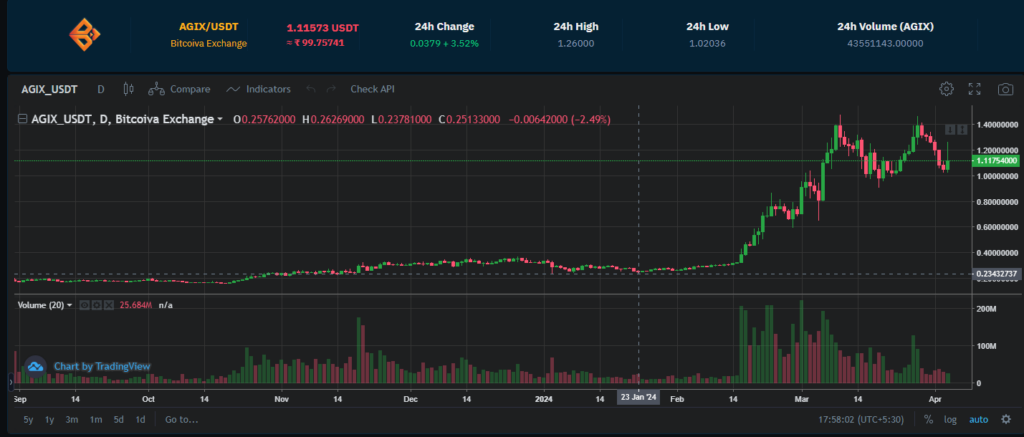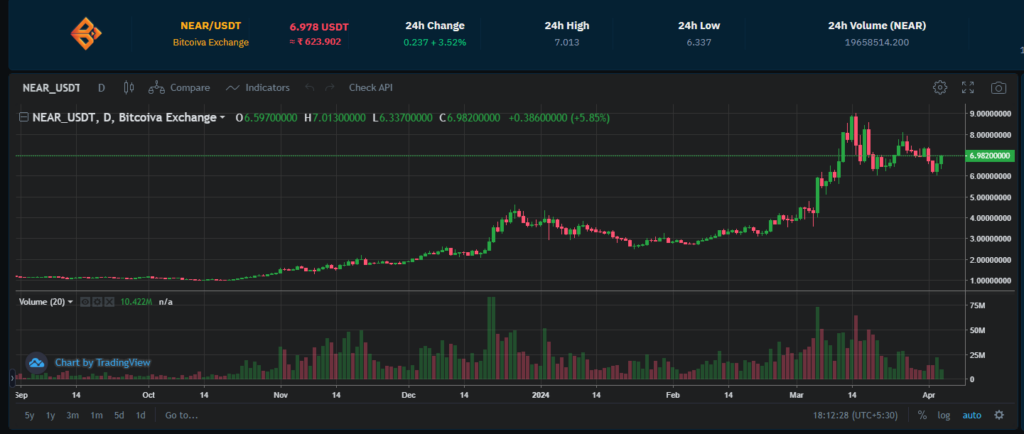Artificial Intelligence and Machine learning have a significant impact on the current marketplace. The OpenAI created chatgpt, designed to create human-like text and tasks such as image processing, developing codings, and generating prompts to generate various AI-based information processing.
What are AI cryptos?
AI crypto coins integrate artificial intelligence to deploy algorithms, trading strategies, and ecosystems. These AI integrations are implemented to improve scalability, efficiency, security, and governance within the cryptocurrency network.
One of the examples of AI crypto projects is (FET), a decentralized machine learning platform for finance and supply chain management applications. Most AI crypto projects are broad and utilize various AI technologies in Blockchain and their networks differently.
Look out for the top AI cryptocurrencies 2024 that make a grand rally on Bitcoiva.
- Fetch.ai (FET)
- SingularityNET (AGIX)
- Internet Computer (ICP)
- Near Protocol (NEAR)
- Injective (INJ)
- Render (RNDR)
- Graph (GRT)
- Ocean (OCEAN)
- Numeraire (NMR)
Why is AI Crypto Booming in 2024?
In early 2024, the AI industry began booming with OpenAI’s Sora product, which generated a big wave of hype within the sector. Traders started to turn their heads towards these cryptos, which caused mega price swings.
Fetch.ai (FET)
Fetch AI (FET) is an Ethereum token that powers Fetch.ai, a decentralized machine learning platform for asset trading, gig economy work, and energy grid optimization applications. Fetch.ai’s first decentralized finance application helps users automate trading with predefined conditions. The FET Utility Token is key to unlocking the Fetch ecosystem used to find, create, deploy, and train autonomous economic agents and smart contracts and transactions required for the digital economy. You can buy a FET Utility Token in Bitcoiva by registering and verifying your KYC documents.

FET utility tokens has increased from $0.43 to $3.40 is approximately a 690.70% increase in Bitcoiva from February to March 2024.
SingularityNET (AGIX)
On December 21, 2017, SingularityNET launched its AGIX token sale, which functions as a utility and governance token. AGIX tokens facilitate transactions within the SingularityNET ecosystem, including payments for AI services, rewards for network participants, and platform development and feature management.
AGIX can be used for staking, governance voting, and as currency on the SingularityNET marketplace. The AGIX Token is currently available on Bitcoiva.

SingularityNET (AGIX) has increased from $0.20 to $1.40 is approximately a 600% increase in Bitcoiva from February to March 2024.
Internet Computer (ICP)
On May 10, 2021, the DFINITY Foundation launched Internet Computer as open source. But now, it acts as an independent network controlled by ICP token holders and supported by the DFINITY Foundation.
ICP is an open and secure blockchain-based network that can host programs and data in smart contracts. It also performs computations on secure, scalable, and reliable smart contracts. ICP is available for trade in Bitcoiva.

Internet Computer (ICP) has increased from $10.59 to $20.99 is approximately 98.23% in Bitcoiva from January 2024 to March 2024.
Near Protocol (NEAR)
NEAR Protocol (NEAR) is a layer-one blockchain launched by a Swiss-based non-profit on April 22, 2020. It functions as a community-run cloud computing platform dedicated to protocol maintenance, ecosystem funding, and directing the protocol’s governance. It aims to provide a user-friendly platform for decentralized applications (DApps) that address challenges such as slow transaction speeds, low throughput, and limited interoperability, a hazard other blockchain networks face.

Near Protocol (NEAR) has percentage increase from $2.46 to $9 is approximately 265.85% in Bitcoiva from January 2024 to March 2024.
Injective (INJ)
Injective Labs created the Injective (INJ) Protocol in 2018 by Eric Chen. Injective is an open, interoperable layer-one blockchain built for finance. It is a next-generation DeFi application that includes prediction markets, lending protocols, decentralized spot, and derivatives exchanges.
Render (RNDR)
RNDR is an ERC-20 utility token launched in 2017 by OTOY, Inc. CEO Jules Urbach. It runs on the Ethereum blockchain and is used by artists on the network in exchange for GPU computing power to verify all the successful art rendered before payment disbursal and art release. The network uses manual and automatic proof of work or render systems.
.
Graph (GRT)
The Graph is one of the more recent cryptoassets, a decentralized indexing protocol for blockchain data. The Graph (GRT) is an open-source blockchain founded in 2018 by Yaniv Tal, Brandon Ramirez, and Jannis Pohlmann. Its main functionality is to enable querying on the Ethereum network and handle chain reorganization, query security, the finality of property, and various issues solved with subgraphs.
Ocean (OCEAN)
The OCEAN token is the native utility token of the protocol, founded in 2017, for data services. It uses blockchain technology to connect data providers and consumers, and it is the default unit of exchange for buying and selling data on the Ocean Market. The Ocean Market app allows data owners to sell data and monitor their data with privacy and control. It is also used for governance and staking.
Numeraire (NMR)
Numerai was founded by Richard Craib in 2015, and the company raised over $21 million in 2020 due to the Numerai project, which has four separate funding rounds. It also issued 1 million NMR tokens to the data scientists who had previously participated in tournaments in 2017. It aims to allow users to trade equities based on machine learning, AI, data science, and cryptography.
Final Thoughts
The integration of these next-generation cryptos with AI in Blockchain networks enhances security, scalability, and efficiency for digital transactions. The rapid growth of AI and Blockchain plays a critical role in the future, and this list is based on internal research; users do thorough research before investing in any crypto.
Visit: www.bitcoiva.com

